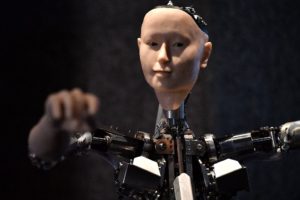Guest blogger:
Eric De Grasse
Chief Technology Officer
Project Counsel Media
Under the title “AI: more than human”, London’s Barbican centre has brought together more than 200 installations, exhibits and projects by artists, scientists and researchers from all over the world
17 May 2019 (Paris, France) – Most of us who have spent any amount of time with artificial intelligence (AI) know the breadth of areas in which AI has been applied: managing the health of the planet, fighting discrimination, improving the use and application of healthcare and medicine, boosting innovation in the arts, etc., etc. The fields in which artificial intelligence can help humans are countless. If you live in/around London (or if you might be visiting for a bit), I urge you to take some time to see a rather ambitious London exhibition that aims to prove that last line.
Under the title “AI: more than human”, the immense Barbican cultural centre brings together more than 200 installations, exhibits and projects by artists, scientists and researchers from all over the world. It runs until August, and visitors will be able to take a journey from the long-held dream of creating artificial life to the reality of today’s most cutting-edge projects. For exhibition hours and other details click here.
NOTE: I got an advance peak earlier this week before it officially opened because one of the Barbican’s curators on the project is a friend of Greg’s.
The exhibit is exhaustive. There is an immersive space by Japanese collective teamLab forms one of the most intriguing exhibits, with art and science combining to let the visitor leave their mark on an evolving digital wall projection. There are also robots of all shapes and sizes, from Sony’s small dog Aibo—whose first version from 1999 has now evolved into an AI model—to a large mechanical arm that prepares and serves cocktails. Other exhibits explore the complex systems that keep big cities ticking over and push forward research into medical conditions from cancer to blindness.
The current limits of AI are investigated, including racial bias and some facial recognition software.

There are robots of all shapes and sizes, including a large mechanical arm that mixes and shakes cocktails
Although the idea of decoding the human brain and imitating its functions was born in the mid-1950s, AI only exploded in 2010 thanks to very fast state-of-the-art processors that allow the analysis of huge amounts of data. The machines have since come on leaps and bounds. IBM’s Deep Blue beat Russian chess champion Garry Kasparov in 1997 while AlphaGo — developed by Google’s DeepMind team — in 2016 beat Lee Sedol, world champion in the 3,000-year-old Chinese board game known as Go. (Greg and I watched it live from Zurich when we were attending one of our AI tutorials at ETH Zurich).
All this is present in the exhibition, helping to outline how AI can help solve problems of enormous complexity, such as climate change. As one of the curators of the exhibit told me
the thing that we dream about would be, what if a machine could say: “here is a clever way of changing how we run our economy that fixes climate”. But for that we need to find a good way of putting human values into machines so they will act without accidentally harming you. The AI could conclude the best solution was to eradicate human beings.
Despite its ambitious scope, the exhibition is only one part of a larger project called “Life Rewired”, which explores the impact of technology on society. The centre recently held a concert of baroque music composed by AI after analysing works by Johann Sebastian Bach. They gave the machine-learning algorithm all of Bach’s keyboard works. That’s a lot of music, but machine-learning needs millions of data points to learn from. The hope was to demonstrate that, rather than competing with humans, AI can help humans “to think outside of our narrow creative window”. Humans get very stuck in ways of thinking, we often end up behaving like machines”.
Do try and see the Barbican exhibit. It’s great fun.
